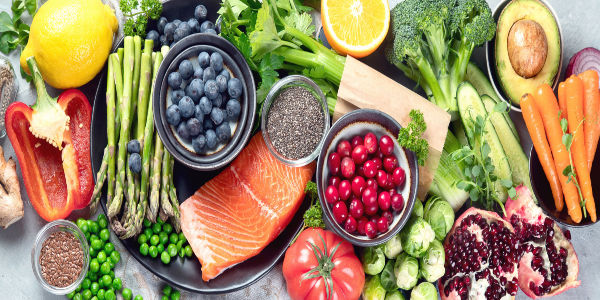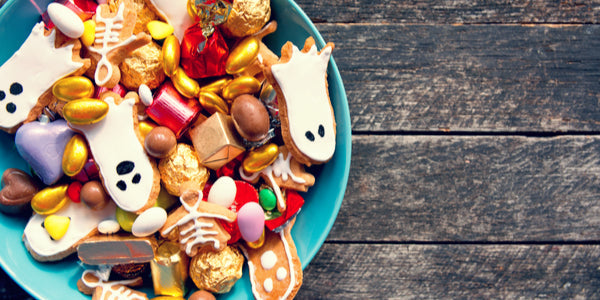
Weight loss can be overwhelming on its own, not to mention the many food and snack options available. Fortunately, an abundance of whole foods for weight loss exist, including popular staples like fruits, vegetables and legumes.
When it comes to the best foods to eat to lose weight, the “best” foods are the foods that fit conveniently into your diet and lifestyle. Ahead, we’ll explore the 23 best foods for weight loss backed by sound research.
How Food Impacts Weight Loss
Food plays a crucial role in weight loss efforts. Not only can food influence fullness (sometimes called satiety), but too many or too few calories can cause shifts in body weight.
When looking to lose weight, many people start by limiting food groups (or getting rid of entire groups altogether). Unfortunately, all too often, this means nutrient intake is limited as well. Protein is especially helpful to keep you feeling full, and can be linked to a condition called protein-energy malnutrition (PEM) if you aren’t getting enough calories.
On the other hand, too many processed foods can contribute to unwanted weight gain. Processed foods generally contain high amounts of unhealthy fats, added sugar, and calories without many vitamins or minerals to accompany them. Consuming processed foods occasionally is okay, but regular consumption of these “empty calories” can make weight loss more difficult.
23 Best Foods for Weight Loss
It’s important to note that food on its own isn’t considered a cure. A healthy diet simply works to enhance the other healthy habits you have. Adequate amounts of sleep, stress management, and exercise can work together synergistically with your diet to help you lose weight.
Fruits and vegetables
Artichoke
Artichokes are an underrated vegetable. A medium artichoke contains about 60 calories, meaning it can fit easily into a weight loss diet. Additionally, artichokes may help to decrease blood pressure.
Beyond the well-loved spinach and artichoke dip, you can incorporate artichokes in recipes such as casseroles, pastas, and salads.
Avocado
Past diet fads blamed fat for weight gain. However, healthy fats are crucial for optimal body function and, not to mention, keeping you feeling full throughout the day.
When preparing a weight loss plan, be sure to include avocados. Instead of containing saturated fats, which are considered “unhealthy,” avocados contain heart-healthy monounsaturated fatty acids.
Additionally, avocados contain fiber and may be able to increase the amount of “good” bacteria in the intestines—which may help to decrease digestive symptoms like bloating.
Berries
Berries—like blueberries, raspberries, and strawberries—contain unique fat-burning properties. This is thanks to unique chemical compounds called phytochemicals, which have the potential to affect fat metabolism in the body.
In other words, berries may be able to improve weight maintenance and assist in healthy weight loss efforts.
Broccoli
Vegetables like broccoli are valuable additions to a weight loss diet. Broccoli is high in fiber, which can help you feel full while losing weight. The specific kind of fiber they contain, called soluble fiber, can go beyond weight loss to help balance blood sugar and even contribute to lowering cholesterol levels.
Cabbage
Used in cuisines all over the world, cabbage can easily fit into a healthy diet. In fact, recent research shows that cabbage may be useful in weight loss efforts, particularly for those seeking to balance blood sugar and prevent type 2 diabetes.
Feel free to choose from green, white, or red cabbage. Another advantage of cabbage is that it can be consumed raw or cooked, making it a very versatile ingredient.
Citrus
Citrus fruits, such as grapefruits, lemons, limes, and oranges, contain plant-based compounds called flavonoids. These compounds are associated with weight loss since they have many potential benefits for the body.
For example, flavonoids from citrus may improve blood sugar balance, regulate fat metabolism, and affect how fat is stored in the body.
Cucumber
Cucumbers are incredibly low-calorie, with only 16 calories per cup. Made of mostly water, cucumbers are one of the most hydrating foods available. They can contribute to meeting your daily fluid requirement and are naturally fat- and cholesterol-free.
Whole Grains
Barley
Like broccoli, hulled barley contributes soluble fiber to the diet. Since this kind of fiber can promote feelings of fullness, which can help avoid giving into cravings for refined carbohydrate-rich foods. Overall, consuming barley can help you take control of your appetite while you lose weight.
Brown Rice
Is rice healthy for you? Well, regular white rice is refined in a way that removes vital nutrients. Brown rice, on the other hand, is typically considered a whole grain because it contains all three parts of the grain (bran, germ, and endosperm).
Due to its high fiber content, brown rice can help keep you feeling fuller than its more processed counterparts. This, in turn, can help curb cravings and prevent overeating patterns that complicate weight loss.
Quinoa
Quinoa is quite a unique whole grain. It contains all nine essential amino acids, which must be obtained from the diet because the body can’t create them on its own.
Another advantage of quinoa is that it’s naturally gluten-free. This makes it a great option for those with gluten sensitivities or allergies. It can be served warm or cold (once cooked), is easy to make, and can be a convenient ingredient in many weight loss meals.
Oats
Craving baked goods? Oats can help you stay on track with your weight loss goals while binding baking ingredients together. They contain high levels of fiber, which can help balance blood sugar and quell cravings.
When losing weight, oats are a key ingredient. This pantry staple can be incorporated in almost every meal, from oatmeal at breakfast to a binder for burgers at dinnertime. Try adding it to a healthy dessert as well, such as a crisp or crumble.
Whole-Grain Crackers
A recent study found that substituting whole grains for refined grains in the diet could ultimately cause an increase in calories lost during the day. Due to high fiber content, snacks like whole-grain crackers work not only to keep you feeling full, but also to aid in your weight loss efforts.
Pairing whole-grain crackers with a dip like hummus or a food like low-fat cheese can help to provide protein to your diet as well (and protein can also help keep you satiated).
Animal-Sourced Protein
Ground Meats
Protein is important for weight loss in many ways. For one, it helps to preserve lean muscle tissue while in a caloric deficit. It also promotes satiety and regulates hunger hormones, amongst other key benefits.
While many cuts of beef or pork aren’t considered “lean,” ground meats generally are. To confirm this, you can look at the label to see the percentage of lean meat (i.e. 93% lean).
Ground meat is a versatile ingredient you can use at home to create your favorite comfort foods—like healthy burgers—while losing weight.
Poultry
Ground poultry, like turkey and chicken, is also an excellent option. In fact, poultry in any form is also regarded as a lean protein. To cut calories and fat even further, many experts recommend removing the skin.
Eggs
Eggs have been often critiqued for their cholesterol levels. However, eggs represent a nearly perfect protein source, since (like the whole-grain quinoa) they contain all nine essential amino acids. Plus, eggs can be enjoyed in their various forms, from hard-boiled to scrambled and beyond.
A single egg is about 75 calories, and contains plenty of protein to keep you feeling full. In fact, one study found that participants eating an egg breakfast ended up consuming less calories at lunch.
Plant-Based Protein
Lentils
With higher levels of protein and fiber, lentils can keep you fueled throughout the day. Along your weight loss journey, lentils can assist by increasing satiety (a feeling of fullness). Lentils work well in the place of common carbohydrates and grains (like rice), and can bulk up recipes like chili or casseroles.
Beans & Peas
Legumes and their edible seeds (called pulses) can also be helpful in designing a weight loss diet. In fact, a recent study found that diets high in legumes can decrease body weight and promote fat loss.
The legume family features foods like lentils, beans, and peas, such as the following popular picks:
• Black beans
• Chickpeas
• Green peas
• Kidney beans
• Lima beans
• Navy beans
Nuts
Nuts are often recommended during weight loss due to their nutrient density. A 1/4 cup of mixed nuts contains around 200 calories, but fortifies the diet with much needed nutrients like protein and fiber. Nuts also supply the diet with healthy fats and fat-soluble vitamins, like vitamin E.
Tree nuts, in particular, can replace carbohydrate-heavy snacks in the diet to promote weight loss, weight maintenance, and a sense of satiety. Unless you have a tree nut allergy, you can safely enjoy the following nuts while trying to lose weight:
• Almonds
• Brazil nuts
• Cashews
• Hazelnuts
• Pecans
• Pistachios
Seeds
Seeds, like nuts, contain plenty of fiber, protein, and healthy fats. They’ve also been implicated in helping to balance hormones, which may make weight management easier. Used as a diet staple since ancient times, seeds are linked to increasing satiety and improving weight management.
Commonly selected seeds include:
• Chia
• Flax
• Pumpkin
• Sesame
• Sunflower
Low-Fat Dairy
Low-Fat Milk
Since each gram of fat contributes 9 calories to the diet, selecting low-fat dairy can help you reduce your calorie intake. Choosing low-fat milk won’t usually affect the amount of protein in your milk (about 8 grams per 1 cup). As mentioned above, getting enough protein is crucial to optimizing body function and feeling full throughout the day.
Low-Fat Cheese
Along with low-fat milk, you can add low-fat cheese to your weight loss diet plan. Cheese like swiss cheese are naturally lower in fat. Other popular varieties, like cheddar or mozzarella, can be purchased in reduced-fat forms or part-skim.
Greek Yogurt
Greek yogurt is similar to regular, plain yogurt, but differs in its nutrient profile. It tends to have less sugar, more protein, and contains some “healthy” fats so you stay satiated. In one study, researchers found that Greek yogurt may promote a lower body fat percentage while improving muscle thickness and strength.
Not just meant for partaking in parfaits, Greek yogurt can be used in everything from baked goods to healthier, homemade sauces and dips. Luckily, it’s also available in low-fat varieties (although you’ll want to keep an eye on the amount of sugar added for flavor).
Fortified Soy Beverages & Products
Fortified soy beverages are considered an adequate substitute if you don’t tolerate dairy well. Compared with other plant-based beverage options, soymilk often stands unparalleled, averaging 8 grams per cup. Be sure to seek out unsweetened varieties or drinks fortified with vitamins and minerals that make them similar to cow’s milk in nutrition.
Soy beverages aren’t the only option for weight loss. Other soy foods, made from soybeans, are generally high in fiber and protein while remaining low in fat and virtually cholesterol-free. As long as you don’t have a soy allergy, you may find the following soy-based foods a good fit for your weight loss diet:
• Edamame
• Soy nuts
• Tempeh
• Tofu
A Final Word on the Best Foods for Weight Loss
A big component of losing body weight is making smart food choices. Fortunately, there are several nutrient-rich foods that can help keep you satiated throughout the day. Particularly, foods high in healthy fat, lean protein, and fiber can fuel you during your weight loss journey.
References:
Academy of Nutrition and Dietetics. Back to Basics for Health Weight Loss. Eatright.org. Published April 2021.
Akbar A, Shreenath AP. High Fiber Diet. Ncbi.nlm.nih.gov. Published May 2022.
Clark SL, Ramdath DD, King BV, O’Connor, Aliani M, et al. Food Type and Lentil Variety Affect Satiety Responses but Not Food Intake in Healthy Adults When Lentils Are Substituted for Commonly Consumed Carbohydrates. J Nutr. 2019;149(7):1180-1188.
Giancoli A, Ellis E. 5 Whole Grains to Keep Your Family Healthy. Eatright.org. Published September 2022.
Henning SM, Yang J, Woo SL, Lee R, Huang J, et al. Hass Avocado Inclusion in a Weight-Loss Diet Supported Weight Loss and Altered Gut Microbiota: A 12-Week Randomized, Parallel-Controlled Trial. Curr Dev Nutr. 2019;3(8):nzz068.
Kalt W, Cassidy A, Howard LR, Krikorian R, Stull AJ, et al. Recent Research on the Health Benefits of Blueberries and Their Anthocyanins. Adv Nutr. 2020;11(2):224-236.
Mahmoud AM, Bautista RJH, Sandhu MA, Hussein OE. Beneficial Effects of Citrus Flavonoids on Cardiovascular and Metabolic Health. Oxid Med Cell Longev. 2019;2019:5484138.
Metropulos M. What are the best foods for weight loss? Medicalnewstoday.com. Published January 2018.
Moradi M, Sohrabi G, Golbidi M, Yarmohammadi S, Hemati N, et al. Effects of artichoke on blood pressure: A systematic review and meta-analysis. Complement Ther Med. 2021;57:102668.
Hernández-Pérez T, Valverde ME, Paredes-López O. Seeds from ancient food crops with the potential for antiobesity promotion. Crit Rev Food Sci Nutr. 2021;62(17):4563-4570.
Petre A. 9 Impressive Health Benefits of Barley. Healthline.com. Published September 2018.
Rupasinghe HPV, Sekhon-Loodu S, Mantso T, Panayiotidis MI. Phytochemicals in regulating fatty acid 𝛃-oxidation: Potential underlying mechanisms and their involvement in obesity and weight loss. Pharmacol Ther. 2016;165:153-163.
Sandoval V, Sanz-Lamora H, Arias G, Marrero PF, Haro D, Relat J. Metabolic Impact of Flavonoids Consumption in Obesity: From Central to Peripheral. Nutrients. 2020;12(8):2393.
U.S. Department of Agriculture. Cucumber, with peel, raw. Fdc.nal.usda.gov. Published 2018.
U.S. Department of Agriculture. Artichokes, (globe or french), raw. Fdc.nal.usda.gov. Published 2018.
Wang J, Wang S, Henning SM, Qin T, Pan Y, et al. Mixed Tree Nut Snacks Compared to Refined Carbohydrate Snacks Resulted in Weight Loss and Increased Satiety during Both Weight Loss and Weight Maintenance: A 24-Week Randomized Controlled Trial. Nutrients. 2021:13(5):1512.
Zhang L, Pagoto S, Olendzki BO, Persuitte G, Churchill L, et al. A nonrestrictive, weight loss diet focused on fiber and lean protein increase. Nutrition. 2018;54:12-18.







